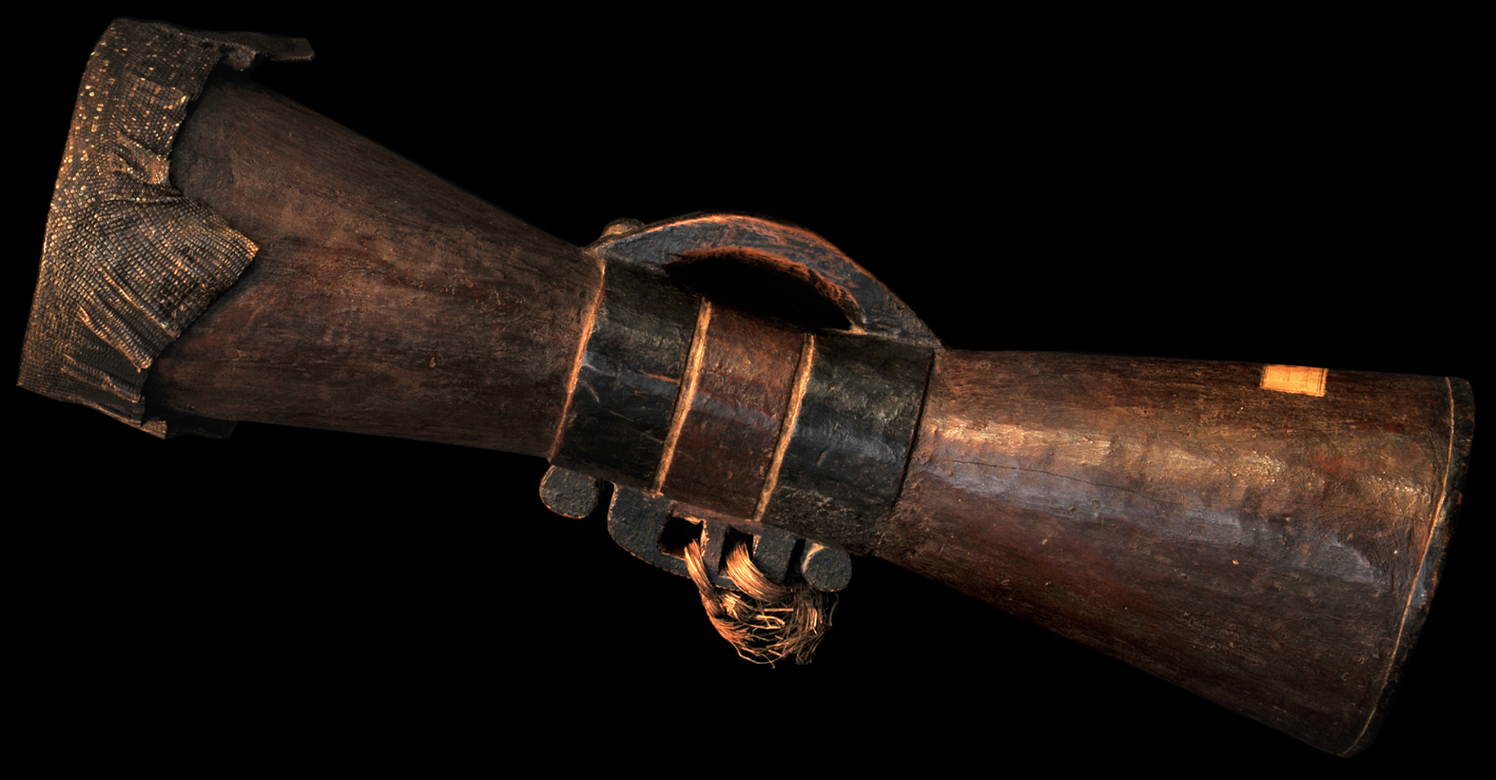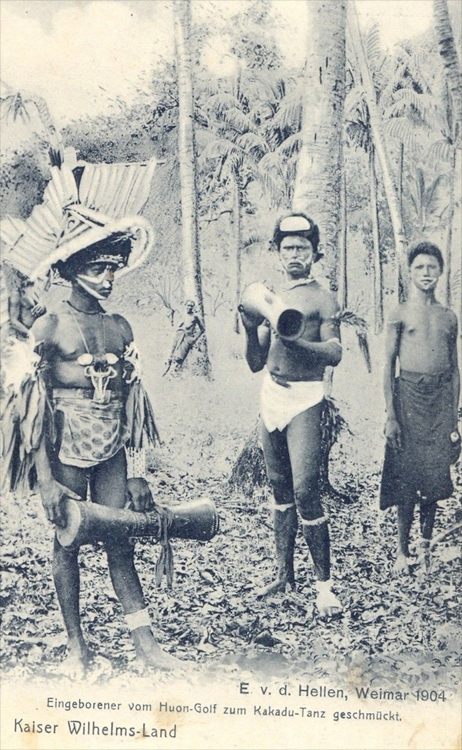DRUMS OF THE WORLD
New Guinea
Huon Gulf drum New Guinea
Huon Gulf drum New Guinea / Trommel Papua Neuguinea
"It is a common feature of the drums made in the Huon Gulf area that they are all narrower in the middle and broader toward the ends, that is, they are shaped like hour-glasses. The opening covered by the skin is surrounded by an indented rim, whereas the uncovered opening on the other side has an embossed ring around it. The handle is similar everywhere: a simple open arc, shorter or longer, carved in a flat or cylindrical shape. The drums are ornamented by carving and engraving. The carved parts are on the side opposite the handle, whereas the engraved designs cover the “waist” of the drum in a width corresponding to the length of the handle; other motifs branch out from them toward the top and bottom opening of the drum.(...) Biró tells us that according to the craftsmen the designs on the "waist" of the drum mean bracelets and motifs peculiar to bracelets."
"The skins of the lizards were simply dried and, without any further preparation, rolled up in a bamboo tube. Before use, the skins were softened in water, stretched tightly over the opening of the drum and firmly bound at the rim; the edge hanging out under the binding was pulled from all sides until the drumhead became evenly taut. First, however, the rim of the drum was smeared with the juice of a tree which glued the skin securely to the wood on drying. Another important material was the wax supplied by the stingless Trigona bees, pea-sized pieces of which were rolled and stuck to the drumhead. If these wax pieces were hit, the drum gave a pleasanter sound. During the dance every man had a nut-sized piece of wax stuck to the handle of the drum, to replace pieces which came off. If the skin began to sag during the dance, it was warmed at the fire to make it taut again, and it was occasionally beaten to tune it."
excerpt from: Bodrogi, Tibor (1961), Art in North-East New Guinea.p.79-81. Budapest: Hungarian Academy of Science.
Bibliography:
Bodrogi, Tibor 1961, Art in North-East New Guinea. Budapest: Hungarian Academy of Science.
Dark, Philip J.C. 1974, Kilenge Art and Life. London: Academy
Finsch, Otto (1888) Reisen in Kaiser Wilhelms-Land und Neu-Guinea an Bord des Dampfers Samoa.
Finsch, Otto (1888)Ethnologische Erfahrungen und Belegstücke aus der Südsee: beschreibender Katalog einer Sammlung im K.K. Naturhistorischen Hofmuseum in Wien.
Living Spirits with Fixed Abodes - edited by Barry Craig
"It is a common feature of the drums made in the Huon Gulf area that they are all narrower in the middle and broader toward the ends, that is, they are shaped like hour-glasses. The opening covered by the skin is surrounded by an indented rim, whereas the uncovered opening on the other side has an embossed ring around it. The handle is similar everywhere: a simple open arc, shorter or longer, carved in a flat or cylindrical shape. The drums are ornamented by carving and engraving. The carved parts are on the side opposite the handle, whereas the engraved designs cover the “waist” of the drum in a width corresponding to the length of the handle; other motifs branch out from them toward the top and bottom opening of the drum.(...) Biró tells us that according to the craftsmen the designs on the "waist" of the drum mean bracelets and motifs peculiar to bracelets."
"The skins of the lizards were simply dried and, without any further preparation, rolled up in a bamboo tube. Before use, the skins were softened in water, stretched tightly over the opening of the drum and firmly bound at the rim; the edge hanging out under the binding was pulled from all sides until the drumhead became evenly taut. First, however, the rim of the drum was smeared with the juice of a tree which glued the skin securely to the wood on drying. Another important material was the wax supplied by the stingless Trigona bees, pea-sized pieces of which were rolled and stuck to the drumhead. If these wax pieces were hit, the drum gave a pleasanter sound. During the dance every man had a nut-sized piece of wax stuck to the handle of the drum, to replace pieces which came off. If the skin began to sag during the dance, it was warmed at the fire to make it taut again, and it was occasionally beaten to tune it."
excerpt from: Bodrogi, Tibor (1961), Art in North-East New Guinea.p.79-81. Budapest: Hungarian Academy of Science.
Bibliography:
Bodrogi, Tibor 1961, Art in North-East New Guinea. Budapest: Hungarian Academy of Science.
Dark, Philip J.C. 1974, Kilenge Art and Life. London: Academy
Finsch, Otto (1888) Reisen in Kaiser Wilhelms-Land und Neu-Guinea an Bord des Dampfers Samoa.
Finsch, Otto (1888)Ethnologische Erfahrungen und Belegstücke aus der Südsee: beschreibender Katalog einer Sammlung im K.K. Naturhistorischen Hofmuseum in Wien.
Living Spirits with Fixed Abodes - edited by Barry Craig



